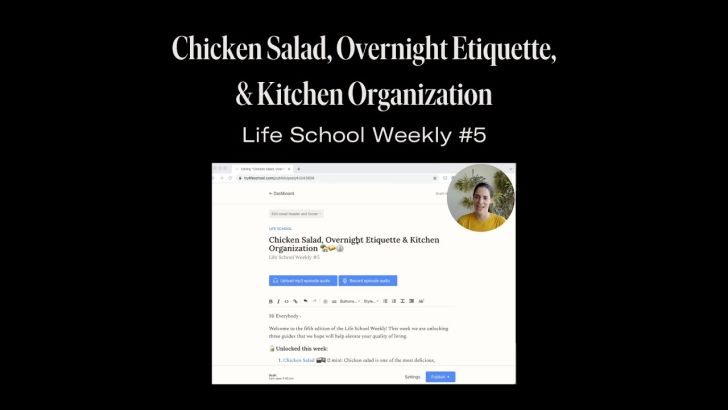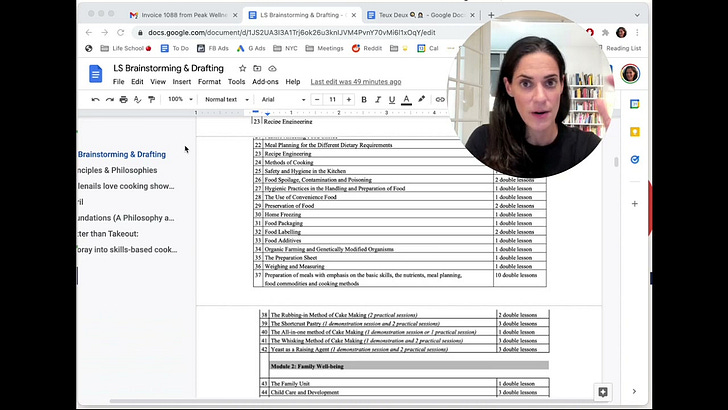This lesson is 913 words, a 3 min 39 sec reading time. It is the fourth lesson of Lunch 2.0.
📍 Introduction:
Leftovers present the ultimate opportunity for an efficient and tasty lunch. Much of the work is already complete, meaning all you must do is spruce things up. With a little know-how on reheating and a couple of go-to dishes, you can create endless possibilities with what you have on hand.
There’s an old saying, “every food has a purpose and a re-purpose.” Working with leftovers is one of the ultimate ways to lean into this philosophy. Both challenging and rewarding, sprucing up leftovers will stretch your prowess as a scrappy home chef. Go ahead, and get creative!
🧂 Ingredients:
Leftovers
Additions
✅ Instructions:
Select leftovers to spruce up
Reheat (optional)
Add base/toppings/sauce/other
Enjoy!
📝 Notes Tips & Tricks:
Storage
Most leftovers will be fine in the fridge for ~5-7 days.
Some items degrade over time (e.g., seafood, anything crispy, fried, or fluffy)
Some items improve (e.g., stews, braised meat, chili, curries, sauces, vinaigrettes, soups, chicken thighs, moist cakes)
If an item makes for great leftovers, cook extra (e.g., roasted vegetables, rice/grains, roasted chicken)
Regularly check your fridge to (1) discard expired items (2) make a plan with ingredients close to expiration (3) identify candidates for freezing (e.g., things you don’t want to use up just yet).
Give your leftovers priority placement in the fridge. Use clear containers so they don’t get lost. Check for both every time you cook.
Masking tape and a sharpie make it easy to label things. If you have roommates consider a color coding system (e.g., blue for “eat” and red for “don’t eat”).
Restaurant Takeout:
Restaurant takeout makes for great leftovers. Order extra portions for later to amortize the delivery & service fees.
Restaurants have an advantage with heavily stocked pantries & skilled labor. They are uniquely able to tackle more challenging tasks (e.g., dishes that require many unique ingredients or multiple steps over long periods of times).
Examples of high-leverage takeout items: housemade salad dressing, dips, sauces, soups, grains, slow-cooked or braised meats, meatballs, dumplings, curry, pasta sauce, bread (e.g., pita, garlic), desserts (e.g., cake).
Many takeout items are worth ordering specifically to freeze. (Freezer Stocking Reference Guide)
Leftover sauce can be frozen for later or used as a marinade (e.g., tikka masala, teriyaki, pesto).
When ordering, ask yourself what you’re in the mood for tonight, but also what can be helpful or enticing tomorrow.
To continue reading please subscribe.
Reheating:
Microwaves can alter food texture (e.g., making it rubbery, chewy). Oven and stove typically maintain texture, although they take longer.
When reheating in a microwave, stir and rotate every ~30-60 seconds.
For items that seem dry (e.g., meat, pasta, rice, veggies), add some moisture (e.g., water, broth, oil, butter, sauce).
To avoid soggy leftovers, try toasting or broiling in the oven.
Food safety tip: when in doubt, reheat items to 165°F.
Sprucing:
FIFO (First In First Out): Whenever possible, use up items with the earliest expiration dates.
Consider your second time eating a dish to be a redemption round for less successful dishes. Adjust spices and seasoning, or add textural elements to get it right.
Overripe fruit makes for great smoothies. Or freeze for later use in jam, baked goods (e.g., banana bread), or oatmeal.
Cooked veggies (e.g., boiled, roasted) make an excellent base for puréed soup.
Popular additions to leftovers: cheese, toasted nuts, grains, herbs, condiments (e.g., soy sauce, hot sauce, mayo), pickled red onions, slaw, chips. (Salad Toppings Reference Guide)
📓 Reheating Leftovers Reference Guide
Pizza: Crisp in oven or toaster oven at 350°F for ~10 min.
Steak: Warm in 275° oven for 20-30 minutes to an internal temp of 110, then sear in a hot skillet to re-crisp the exterior. Or sauté. Do not overheat, or it will get tough & dry.
Roasted chicken: Wrap in foil and reheat at 325 until warmed through, or chop up and reheat in a saute pan with a little bit of olive oil, water, or stock.
Salmon: Warm in the oven at 200 for 20 min.
Roasted vegetables: Microwave (check every 30-60 seconds) or sauté for ~5 min.
Rice: Microwave (covered) with a little added water for ~1-2 min.
Soup: Bring to a simmer in a small pot. Or, microwave with a small saucer/plate underneath for easier handling.
Sandwich: Separate components, heat separately, & reassemble. Or make a panini & heat in a pan.
📓 Sprucing Up Leftovers Reference Guide
Grain Bowl: Use leftover grains (e.g., rice, quinoa) as a base to top with chopped/heated leftovers. Add missing flavor & texture elements (e.g., sliced avocado, boiled egg).
Fried Rice: Use up leftover rice (1+ days ideal so rice is drier). Scramble an egg, chop & set aside. Sauté diced onion (scallion, garlic, ginger), then leftover diced up vegetables/protein, then rice. Add sauce (soy sauce, sesame oil, sriracha) & egg at the last minute.
Salad: Use up leftover dressing on fresh greens. Chop & add leftover grains, veggies, greens, or diced up proteins (Salad Toppings Reference Guide).
Sandwich: Toast bread in a pan or toaster oven. Add condiments, leftovers. Choose additions/toppings that round out flavor & texture elements.
Soup: Can use up nearly any leftover (e.g., vegetables, grains, meat)
Hash: Cube and sauté leftover potatoes (and/or other veggies and meat) with diced onion until golden and crispy. Top with herbs, ketchup, a fried egg, or grated cheese.
Omelet/Frittata: Chop & heat up leftovers. Set aside. Make an omelet or frittata egg base. Add leftovers & desired additions (e.g., cheese, veggies).
Pasta dish: Chop & heat up leftovers (e.g., sauté roasted vegetables). Add to cooked pasta. Add sauce (optional).
Baked Potato: Bake a potato & add toppings.
Nosh Plate: Add sides (e.g., cheese, olives, slaw, pickles, other leftovers, bread, veggies).
Burrito/Quesadilla: Heat up leftovers & tortilla. Add guac/sour cream/beans/cheese.
Smoothies: Great for using up leftover fruit & veg.
Stir Fry: Sauté leftover meat & veggies. Add a soy-based sauce.
Quiche: Ideal for using up leftover veggies & cheese. Can be crustless if no pie dough on hand.
🎓 Further Study
Salad Toppings Reference Guide [Life School]
Sandwich Reference Guide [Life School]
Freezer Stocking Reference Guide [Life School]
———
📚 Want more? Check out the Table of Contents or Collections.
🎧 Prefer to listen? Subscribe on iTunes, Spotify, or Overcast.










